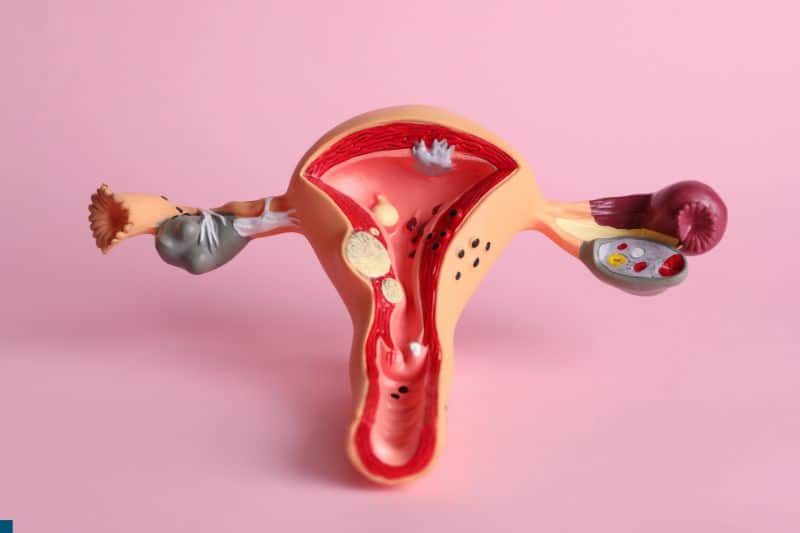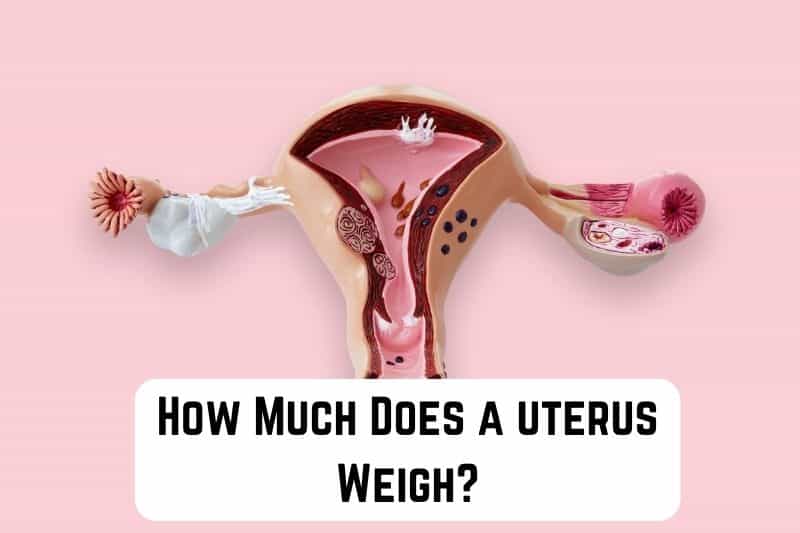You might be curious about the weight of the uterus, a vital reproductive organ in females. The uterus is essential during pregnancy, as it holds and nurtures the developing fetus. Understanding its weight can give us better insight into this essential organ’s overall health and function.
Typically, the average weight of a non-pregnant uterus is around 50 to 100 grams, or 1.7 to 3.5 ounces. However, it’s crucial to note that the weight of your uterus can vary depending on your age, hormonal fluctuations, and any existing medical conditions. Consult with a healthcare professional if you have concerns about your uterus or overall reproductive health.
Read: How Much Does a Heart Weigh?
The average weight of a non-pregnant uterus is around 50 to 100 grams, or 1.7 to 3.5 ounces. However, when fibroids are present, the uterus can weigh significantly more. Depending on the size and number of fibroids, the uterus can weigh anywhere from 100 grams (3.5 ounces) to as much as 1,000 grams (2.2 pounds) or sometimes even more.
Measuringly.com
Understanding Uterus Weight
Your uterus is an extraordinary organ that plays a crucial role in your reproductive system. Even though its size and weight may not seem significant, it’s essential to know that the uterus’ weight can vary depending on several factors.
In a non-pregnant adult, the uterus typically weighs around 60-90 grams (2-3 ounces). This small, muscular organ sits low in your pelvis and is shaped like an upside-down pear. While it is quite compact, it can expand up to 500 times its usual size during pregnancy.
It’s important to realize that a uterus’s weight can change throughout a woman’s life. For example, during puberty, the uterus grows more prominent, and the reproductive organs begin to mature.
Consequently, the weight of the uterus increases slightly. Likewise, after menopause, the uterus tends to shrink, potentially reducing its overall weight.
Hormones also play a key role in uterus size and weight. Fluctuations in hormone levels throughout your menstrual cycle can cause the uterus to become temporarily enlarged, even when you are not pregnant.
Overall, understanding the average weight of a uterus can give you vital insights into your reproductive health and better equip you to address any concerns that may arise. By being knowledgeable about your body, you are better prepared to take steps to maintain a healthy lifestyle and reproductive system.
Factors Influencing Uterus Weight
Several factors can influence the weight of your uterus. It’s essential to be aware of these factors, as variations in weight can impact your reproductive health. This section will focus on age and hormonal changes as the main contributors to uterus weight fluctuations.
Age
As you grow older, the weight of your uterus may change. In young girls, the uterus is small and weighs around 30 grams. Once puberty hits and menstruation begins, the uterus grows in size.
A woman’s uterus can weigh anywhere between 60 to 110 grams during childbearing. After menopause, the uterus often shrinks in size due to decreased hormone production and may weigh less than before. It’s important to note that these weight ranges are only approximate, and individual differences might exist.
Hormonal Changes
Your uterus weight can also be affected by hormonal changes happening in your body. Hormones such as estrogen and progesterone play a significant role in maintaining the size and function of the uterus. When hormone levels fluctuate due to your menstrual cycle, pregnancy, or menopause, the uterus can either increase or decrease in size.
For example, the uterus expands during pregnancy to accommodate the growing fetus. This can cause the uterus’s weight to increase significantly, reaching up to 1,100 grams at full term. Once the baby is born, the uterus slowly returns to its pre-pregnancy size and weight.
Another instance where hormonal changes affect uterus weight is during your menstrual cycle. Increases in estrogen levels can cause the uterus to be heavier during the first half of your cycle, while progesterone levels during the second half might prompt the uterus to shed and decrease in weight.
It’s important to remember that these are just some of the factors that can influence your uterus’s weight. Several other factors, such as genetics, lifestyle, and overall health, can also play a role. Therefore, understanding these factors can help you better understand your reproductive system and contribute to maintaining your reproductive health.

Comparing Uterus Weight
When you’re trying to understand the weight of a uterus, it’s essential to consider that the weight can vary depending on several factors. In general, a healthy adult uterus weighs around 60 to 120 grams. However, this weight may change due to factors such as age, hormonal changes, and pregnancy.
During a woman’s menstrual cycle, the uterus can experience changes in weight as it prepares for the possibility of pregnancy. Hormonal fluctuations can cause the uterine lining to thicken, which might add a small amount of weight to the gland. While this difference is typically minimal, it’s essential to recognize that your uterus may not have a completely stable weight throughout your cycle.
In the case of pregnancy, your uterus will undergo significant changes. During the first trimester, the uterus expands to accommodate the growing fetus, and its weight can increase to about 500 grams.
As the pregnancy progresses, the uterus grows, reaching up to 1,000 grams or more during the third trimester. It’s imperative to consider these substantial differences when comparing uterus weights.
Furthermore, medical conditions such as uterine fibroids can also influence the weight of your uterus. Uterine fibroids are noncancerous growths that can vary in size and number. Fibroids can considerably increase the uterus’s weight, sometimes even causing it to weigh as much as 900 grams or more in severe cases.
To recap, the weight of your uterus can differ significantly based on various factors including:
- Age
- Hormonal changes
- Pregnancy
- Medical conditions, such as uterine fibroids
Keep in mind that these factors can lead to fluctuations in uterus weight, making it essential to view this information as a general guide rather than an exact measurement for every woman.
Uterus Weight in Different Stages of Life
Uterus Weight in Childhood
At birth, the uterus weighs around 4 to 5 grams and maintains this weight throughout childhood. During this time, the uterus is relatively small – around 3.5 centimeters in length and 2 centimeters in width. As you enter puberty, hormonal changes cause the uterus to grow and prepare for menstruation.
Uterus Weight in Reproductive Years
Once you reach reproductive age, your uterus size and weight fluctuate depending on hormonal changes, menstrual cycle, and pregnancy. On average, a non-pregnant uterus weighs between 40 to 80 grams.
The dimensions of the uterus also vary, ranging from 7.5 to 10 centimeters in length and 5 to 6 centimeters in width. The uterus lining thickens in anticipation of a fertilized egg during each menstrual cycle, causing subtle changes in its weight.
- Pre-pregnancy: 40-80 grams
- During menstruation: Slightly heavier due to thickened lining
Uterus Weight Post Menopause
After menopause, your uterus gradually becomes smaller and lighter due to decreased estrogen levels. The uterus may shrink to about half its size, weighing approximately 20 to 30 grams. The dimensions of the uterus also contract, measuring around 6 to 7.5 centimeters in length and 3 to 4 centimeters in width.
Remember that these figures are just general averages, and individual variations can occur. It’s important to listen to your body; consult a healthcare professional if you feel concerned about your uterus.
Impact of Medical Conditions on Uterus Weight
Fibroids
Fibroids are non-cancerous growths that develop in or around your uterus. They can vary in size, from as small as a pea to as large as a melon. As you might imagine, having fibroids can impact the weight of your uterus.
If you have multiple or particularly large fibroids, your uterus may weigh more than the average of 50 to 100 grams. To help manage symptoms, maintain a healthy lifestyle, and discuss possible treatment options with your healthcare provider.
Endometriosis
Endometriosis is where the tissue that typically lines your uterus, called the endometrium, grows outside the uterine cavity. This can lead to inflammation and scar tissue formation, which in turn can impact the weight of your uterus.
While endometriosis itself doesn’t directly add much weight to the uterus, the inflammation and scarring can make your uterus feel heavier. Dealing with endometriosis can be challenging, but treatments, such as hormonal therapy and surgery, are available to manage the condition. Consult with your healthcare provider to determine the best course of action.
Read: How Much Does a Human Skeleton Weigh?
Uterine Polyps
Uterine polyps are growths that arise from the surface of your uterus, typically within the endometrial lining. They are usually benign, but occasionally they can be cancerous. Uterine polyps can impact the weight of your uterus, though the overall weight gain is generally minimal.
Small polyps may not cause any symptoms, while larger ones can cause abnormal bleeding or pain. Treatment options for uterine polyps include observation, medication, or surgical removal, depending on the size and location of the polyps, as well as your circumstances.
How Much Does a Uterus Weigh with Fibroids?
Let’s discuss the weight of a uterus with fibroids. Fibroids, also called leiomyomas, are non-cancerous growths in the uterus. Their size and number can greatly affect the weight of the uterus.
Typically, a healthy uterus weighs around 50-1000 grams. However, when fibroids are present, the uterus can weigh significantly more. Depending on the size and number of fibroids, the uterus can weigh anywhere from 100 grams (3.5 ounces) to as much as 1,000 grams (2.2 pounds) or sometimes even more.
There are various factors that influence the weight of the uterus with fibroids:
- Size of fibroids: Fibroids can range from the size of a pea to as large as a grapefruit. Larger fibroids often lead to a heavier uterus.
- Number of fibroids: Multiple fibroids can contribute to an increased uterus weight. Some women may have only one fibroid, while others may have several.
- Location of fibroids: Fibroids can grow within the uterine wall, on the outer surface, or within the uterine cavity. Depending on their location, fibroids can cause the uterus to expand, leading to additional weight.
Keep in mind that every woman’s body is different, and individual uterus weight can vary. It’s important to consult with your healthcare professional if you have concerns about fibroids or any other uterine-related issues. They can provide personalized information and advice tailored to your situation.
How Much Does a Uterus and Cervix Weigh in Pounds?
When you think about your reproductive system, have you ever wondered how much your uterus and cervix actually weigh? Well, it’s a fascinating topic! Let’s break it down and discover the approximate weight of these essential organs in pounds.
On average, a healthy, non-pregnant uterus weighs approximately 1.76 ounces (50 grams), approximately 0.11 pounds. It’s a small, yet mighty, organ that is roughly the size and shape of an upside-down pear.
As for the cervix, it generally weighs less than the uterus. The average weight of a cervix is around 0.71 ounces (20 grams) or about 0.044 pounds.
Now, you may be curious about what could cause variations in weight. Here are a few factors that could affect the weight of a person’s uterus and cervix:
- Age: As you grow older, your uterus might change in size and weight. During menopause, the uterus may shrink due to reduced estrogen levels in the body.
- Fibroids: These noncancerous growths can develop in or on the uterus, causing it to weigh more than usual. The additional weight depends on the size and number of fibroids present.
- Adenomyosis: This condition occurs when the inner lining of the uterus grows into the muscular wall of the uterus, resulting in an enlarged and heavier uterus.
It’s important to remember that these weights are average estimates, and individual cases may vary. Consult with your healthcare provider if you have concerns about the size or weight of your uterus or cervix, or if you experience any unusual symptoms.
Read: How Much Does a Kidney Weigh: Your Guide to Kidney
How Much Does a Uterus and Ovaries Weigh?
Your uterus, also known as the womb, is a small, muscular organ in your lower abdomen responsible for housing and nourishing a developing fetus during pregnancy. Interestingly, your uterus’s weight varies depending on factors like age, reproductive history, and hormonal balance.
A non-pregnant uterus weighs about 50-200 grams, or roughly 1.8 to 7 ounces. Its dimensions are approximately 7.5 cm long, 5 cm wide, and 2.5 cm deep. However, it’s essential to mention that these numbers can change throughout a person’s life.
Now let’s look at your ovaries. These are two small, almond-shaped organs found on either side of your uterus. They are responsible for producing eggs and hormones, primarily estrogen and progesterone. Generally, each ovary weighs around 4-8 grams or 0.14-0.28 ounces. The dimensions of your ovaries are about 3 cm long, 1.5 cm wide, and 1 cm deep.
When considering both uterus and ovaries together, the total weight ranges from approximately 58 to 216 grams (2 to 7.6 ounces). It’s important to remember that these figures represent average weights and dimensions, and individual variations do occur.
Some factors that may affect the weight and size of your uterus and ovaries include:
- Age: During the reproductive years, your uterus and ovaries tend to be heavier, while after menopause, they often decrease in size and weight due to hormonal changes.
- Pregnancy history: A uterus that has never been pregnant, called a nulliparous uterus, is typically smaller and lighter than a multiparous uterus, which has carried one or more pregnancies.
- Hormonal fluctuations: The menstrual cycle can cause temporary changes in your uterus and ovaries’ size and weight due to the production and release of







